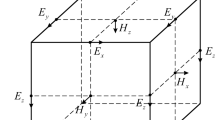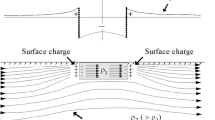Abstract
Controlled-source audio-frequency magnetotellurics (CSAMT) is an important geophysical tool which has been widely used in many areas, such as mineral surveys and groundwater and geothermal exploration. Numerous studies have shown that resistivity anisotropy has a significant influence on CSAMT responses, while another important physical parameter—magnetic susceptibility—is often neglected. In fact, for items such as magnetic minerals, steel pipes and concrete reinforcing bars, the magnetic susceptibility is often non-negligible. However, to the best of our knowledge, there are no three-dimensional (3D) CSAMT studies that have taken both resistivity anisotropy and magnetic susceptibility anisotropy into consideration. Therefore, we present a 3D CSAMT forward modeling algorithm which is capable of handling 3D resistivity and susceptibility anisotropic anomalies using the finite element method. In the far-field zone, this algorithm shows highly accurate results by comparison with the analytical and numerical solutions of MT. Then, the responses of four different models are studied. The results show that for magnetic anomalies with low resistivity contrast, the consideration of magnetic susceptibility is essential, as high susceptibility may seriously distort or even invert its responses.























Similar content being viewed by others
References
Cai, H., Xiong, B., Han, M., & Zhdanov, M. (2014). 3D controlled-source electromagnetic modeling in anisotropic medium using edge-based finite element method. Computers and Geosciences, 73, 164–176.
Chen J., Tompkins M., Zhang P., Wilt, M., Mackie, R. (2012). Frequency-domain EM modeling of 3D anisotropic magnetic permeability and analytical analysis[M]//SEG Technical Program Expanded Abstracts 2012. Society of Exploration Geophysicists: 1–5.
Everett, M. E. (2010). Advances in near-surface applied electromagnetic geophysical techniques with selected applications. Presented at the 20th Electromagnetic Induction Workshop, September 18–23, 2010.
Everett, M. E. (2012). Theoretical developments in electromagnetic induction geophysics with selected applications in the near surface. Surveys in Geophysics, 33, 29–63.
Farquharson, C. G., & Miensopust, M. P. (2011). Three-Dimensional Finite-Element Modeling of Magnetotelluric Data with a Divergence Correction: Journal of Applied Geophysics, 75(4), 699–710.
Feng, D., Ding, S., & Wang, X. (2019). An exact PML to truncate lattices with unstructured-mesh-based adaptive finite element method in frequency domain for ground penetrating radar simulation. Journal of Applied Geophysics, 170, 103836.
Hagiwara, T. (2012). Determination of dip and anisotropy from transient triaxial induction measurements. Geophysics, 77(4), D105–D112.
Han, B., Li, Y., & Li, G. (2018). 3-D forward modeling of magnetotelluric fields in general anisotropic media and its numerical implementation in Julia. Geophysics, 83(4), 1–45.
He, G., Xiao, T., Wang, Y., et al. (2019). 3D CSAMT modeling in anisotropic media using edge-based finite-element method. Exploration Geophysics, 50(1), 42–56.
Hu, X., Peng, R., Wu, G., Wang, W., Huo, G., & Han, B. (2013). Mineral exploration using CSAMT data: Application to Longmen region metallogenic belt, Guangdong Province, China. Geophysics, 78, B111–B119.
Hu, Y. C., Li, T. L., Fan, C. S., et al. (2015). Three-dimensional tensor controlled-source electromagnetic modeling based on the vector finite-element method[J]. Applied Geophysics, 12(1), 35–46.
Hunt, C. P., Moskowitz, B. M., & Banerjee, S. K. (1995). Magnetic properties of rocks and minerals. Rock Physics and Phase Relations, 3, 189–204.
Jin, J. M. (2002). The finite element method in electromagnetics (2nd ed.). John Wiley and Sons.
Key, K. (2009). 1D inversion of multicomponent, multifrequency marine CSEM data: Methodology and synthetic studies for resolving thin resistive layers. Geophysics, 74, F9–F20.
Koldan, J., Puzyrev, V., de la Puente, J., Houzeaux, G., & Cela, J. M. (2014). Algebraic multigrid preconditioning within parallel finite-element solvers for 3-D electromagnetic modeling problems in geophysics. Geophysical Journal International, 197(3), 1442–1458.
Kong, W., Lin, C., Tan, H., Peng, M., Tong, T., & Wang, M. (2018). The effects of 3D electrical anisotropy on magnetotelluric responses: Synthetic case studies. Journal of Environmental and Engineering Geophysics, 23, 61–75.
Li, J., Farquharson, C. G., & Hu, X. (2016). 3D vector finite-element electromagnetic forward modeling for large loop sources using a total-field algorithm and unstructured tetrahedral grids. Geophysics, 82(1), E1–E16.
Li, S., Rouet, F. H., Liu, J., et al. (2018). An efficient hybrid tridiagonal divide-and-conquer algorithm on distributed memory architectures. Journal of Computational and Applied Mathematics, 344, 512–520.
Lin, C., Tan, H., Shu, Q., Tong, T., & Tan, J. (2012). Three-dimensional conjugate gradient inversion of CSAMT data. Chinese Journal of Geophysics (in Chinese), 55(11), 3829–3838.
Linde, N., & Pedersen, L. B. (2004). Evidence of electrical anisotropy in limestone formations using the RMT technique. Geophysics, 69(4), 909–916.
Liu, Y., Junge, A., Yang, B., et al. (2019). Electrically anisotropic crust from three-dimensional magnetotelluric modeling in the Western Junggar. NW China, Journal of Geophysical Research: Solid Earth, 124(9), 9474–9494.
Liu, Y., Xu, Z., & Li, Y. (2018). Adaptive finite element modeling of three-dimensional magnetotelluric fields in general anisotropic media. Journal of Applied Geophysics, 151, 113–124.
Løseth, L. O., & Ursin, B. (2007). Electromagnetic fields in planarly layered anisotropic media. Geophysical Journal International, 170(1), 44–80.
Meglich, T., Li, Y., Pasion, L., Olderburg, D., Van Dam, R. L., & Billings, S. (2008). Characterization of frequency-dependent magnetic susceptibility in UXO electromagnetic Geophysics[M]//SEG Technical Program Expanded Abstracts. Society of Exploration Geophysicists, 2008, 1248–1252.
Mukherjee, S., & Everett, M. E. (2011). 3D controlled-source electromagnetic edge-based finite element modeling of resistive and permeable heterogeneities. Geophysics, 76(4), F215–F226.
Newman, G. A., Commer, M., & Carazzone, J. J. (2010). Imaging CSEM data in the presence of electrical anisotropy. Geophysics, 75(2), F51–F61.
Pek, J., & Santos, F. A. (2002). Magnetotelluric impedances and parametric sensitivities for 1-D anisotropic layered media. Computers and Geosciences., 28(8), 939–950.
Rahmani, A. R., Athey, A. E., Chen, J., & Wilt, M. J. (2014). Sensitivity of dipole magnetic tomography to magnetic nanoparticle injectates. Journal of Applied Geophysics, 103, 199–214.
Ren, Z., Chen, H., Tang, J., & Zhou, F. (2018). A volume-surface integral approach for direct current resistivity problems with topography. Geophysics, 83(5), 1–46.
Rivera-Rios, A. M., Zhou, B., Heinson, G., et al. (2019). Multi-order vector finite element modeling of 3D magnetotelluric data including complex geometry and anisotropy. Earth, Planets and Space, 71(1), 92.
Sasaki, Y., Kim, J. H., & Cho, S. J. (2010). Multidimensional inversion of loop-loop frequency-domain EM data for resistivity and magnetic susceptibility. Geophysics, 75(6), F213–F223.
Starostenko, V. I., Shuman, V. N., Ivashchenko, I. N., Legostaeva, O. V., Savchenko, A. S., & Skrinik, O. Y. (2009). Magnetic fields of 3-D anisotropic bodies: Theory and practice of calculations. Izvestiya, Physics of the Solid Earth, 45(8), 640–655.
Savik, P. N., Jakobsen, M., Lien, M., & Berre, I. (2014). Anisotropic effective conductivity in fractured rocks by explicit effective medium methods. Geophysical Prospecting, 62(6), 1297–1314.
Swidinsky, A., Kohnke, C., & Edwards, R. N. (2018). The electromagnetic response of a horizontal electric dipole buried in a multi-layered earth. Geophysical Prospecting, 66(1), 240–256.
Troiano, A., Giuseppe, M. G. D., Petrillo, Z., Patella, D. (2009). Imaging 2D structures by the CSAMT method: Application to the Pantano di S. Gregorio Magno faulted basin (Southern Italy). Journal of Geophysics and Engineering, 6(2), 120–130.
Wang, K., & Tan, H. (2017). Research on the forward modeling of controlled-source audio-frequency magnetotelluric in three-dimensional axial anisotropic media. Journal of Applied Geophysics, 146, 27–36.
Wannamaker, P. E. (1997). Tensor CSAMT survey over the Sulphur Springs thermal area, Valles Caldera, New Mexico, United States of America, Part I: Implications for structure of the western caldera. Geophysics, 62(2), 451–465.
Wannamaker, P. E. (2005). Anisotropy versus heterogeneity in continental solid earth electromagnetic studies: Fundamental response characteristics and implications for physicochemical state. Surveys in Geophysics, 26(6), 733–765.
Xiao, T., Liu, Y., Wang, Y., et al. (2018). Three-dimensional magnetotelluric modeling in anisotropic media using edge-based finite element method[J]. Journal of Applied Geophysics, 149, 1–9.
Xiao, T., Huang, X., & Wang, Y. (2019). Three-dimensional magnetotelluric modeling in anisotropic media using the A-phi method. Exploration Geophysics, 50(1), 31–41.
Xiao, T., Wang, Y., Huang, X., et al. (2019b) MT responses of three-dimensional resistive and magnetic anisotropic anomalies. Geophysical Prospecting.
Yadav, G. S., & Lal, T. (1997). A Fortran 77 program for computing magnetotelluric response over a stratified earth with changing magnetic permeability. Computers and Geosciences, 23(10), 1035–1038. https://doi.org/10.1016/S0098-3004(97)00089-7
Yin, C. (2000). Geoelectrical inversion for a one-dimensional anisotropic model and inherent non-uniqueness. Geophysical Journal International, 140(1), 11–23.
Younis, A., El-Qady, G., Abd Alla, M., Zaher, M. A., Khalil, A., Al Ibiary, M., & Saraev, A. (2014). AMT and CSAMT methods for hydrocarbon exploration at Nile delta, Egypt. Arabian Journal of Geosciences, 8(4), 1965–1975.
Acknowledgements
Thanks to Dr. Kerry Key for his 1D CSEM modeling code (Dipole1D).
Funding
This work is co-funded by National Natural Science Foundation of China (42104078) and the Open Research Fund from State Key Laboratory of High performance Computing of China (HPCL) (Grant No. 202101-01).
Author information
Authors and Affiliations
Corresponding author
Ethics declarations
Conflict of interest
The authors declare no conflict of interest.
Additional information
Publisher's Note
Springer Nature remains neutral with regard to jurisdictional claims in published maps and institutional affiliations.
Appendix A: The Electromagnetic Fields of Model 4.1
Appendix A: The Electromagnetic Fields of Model 4.1
For Model 4.1, the electric fields \({E}_{x}\) and the magnetic fields \({H}_{y}\) of source \({T}_{b}\) along x = 0 m with different magnetic susceptibilities (0, 0.2, 0.5 and 1). The first row corresponds to the electric field amplitudes and the second row corresponds to the magnetic field amplitudes. The first to fifth columns correspond to frequencies of 500 Hz, 100 Hz, 20 Hz, 10 Hz and 1 Hz. The four curves with different colors (red, black, blue and green, respectively) correspond to magnetic susceptibilities of 0, 0.2, 0.5 and 1
For Model 4.1, the electric fields \({E}_{y}\) and the magnetic fields \({H}_{x}\) of source \({T}_{a}\) along x = 0 m with different magnetic susceptibilities (0, 0.2, 0.5 and 1). The first row corresponds to the electric field amplitudes and the second row corresponds to the magnetic field amplitudes. The first to fifth columns correspond to frequencies of 500 Hz, 100 Hz, 20 Hz, 10 Hz and 1 Hz. The four curves with different colors (red, black, blue and green, respectively) correspond to magnetic susceptibilities of 0, 0.2, 0.5 and 1
For Model 4.1, the electric fields \({E}_{x}\) and the magnetic fields \({H}_{y}\) of source \({T}_{a}\) along x = 0 m with different magnetic susceptibilities (0, 0.2, 0.5 and 1). The first row corresponds to the electric field amplitudes and the second row corresponds to the magnetic field amplitudes. The first to fifth columns correspond to frequencies of 500 Hz, 100 Hz, 20 Hz, 10 Hz and 1 Hz. The four curves with different colors (red, black, blue and green, respectively) correspond to magnetic susceptibilities of 0, 0.2, 0.5 and 1
For Model 4.1, the yx-mode apparent resistivities along x = 0 m for three frequencies (500 Hz, 100 Hz and 20 Hz) which can be seen as plane waves. The left to right correspond to frequencies of 500 Hz, 100 Hz and 20 Hz, respectively. The four curves with different colors (red, black, blue and green, respectively) correspond to magnetic susceptibilities of 0, 0.2, 0.5 and 1
Rights and permissions
About this article
Cite this article
Tiaojie, X., Xiangyu, H., Lianzheng, C. et al. The Effects of Magnetic Susceptibility on Controlled-Source Audio-Frequency Magnetotellurics. Pure Appl. Geophys. 179, 2327–2349 (2022). https://doi.org/10.1007/s00024-022-03050-8
Received:
Revised:
Accepted:
Published:
Issue Date:
DOI: https://doi.org/10.1007/s00024-022-03050-8








